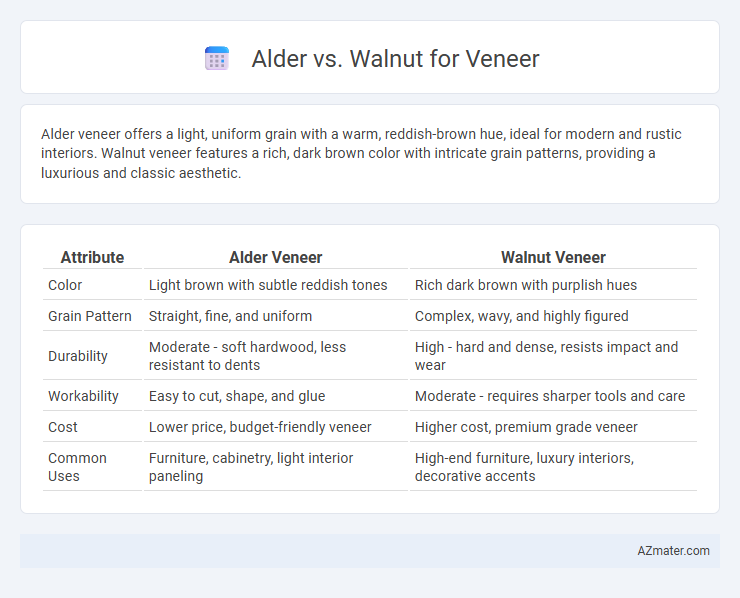Alder veneer offers a light, uniform grain with a warm, reddish-brown hue, ideal for modern and rustic interiors. Walnut veneer features a rich, dark brown color with intricate grain patterns, providing a luxurious and classic aesthetic.
Table of Comparison
| Attribute | Alder Veneer | Walnut Veneer |
|---|---|---|
| Color | Light brown with subtle reddish tones | Rich dark brown with purplish hues |
| Grain Pattern | Straight, fine, and uniform | Complex, wavy, and highly figured |
| Durability | Moderate - soft hardwood, less resistant to dents | High - hard and dense, resists impact and wear |
| Workability | Easy to cut, shape, and glue | Moderate - requires sharper tools and care |
| Cost | Lower price, budget-friendly veneer | Higher cost, premium grade veneer |
| Common Uses | Furniture, cabinetry, light interior paneling | High-end furniture, luxury interiors, decorative accents |
Introduction to Alder and Walnut Veneer
Alder veneer is known for its smooth grain and warm, reddish-brown hue, making it ideal for furniture and cabinetry that require a soft, uniform appearance. Walnut veneer features a rich, dark brown color with striking grain patterns, offering a luxurious and elegant finish favored in high-end interior design. Both veneers provide durability and versatility, but walnut is often chosen for its distinctive aesthetic, while alder is preferred for its affordability and ease of staining.
Appearance and Grain Patterns
Alder veneer displays a smooth texture with a consistent, fine grain that often features subtle, straight patterns and occasional knots, providing a warm, light to medium brown tone ideal for rustic or traditional designs. Walnut veneer showcases a rich, dark brown color with striking, irregular grain patterns that can include waves, curls, and swirls, creating a luxurious and sophisticated look. The contrast between Alder's uniform grain and Walnut's dynamic, bold patterns makes each species uniquely suitable for different aesthetic preferences in furniture and cabinetry.
Color Variations: Alder vs Walnut
Alder veneer features light to medium brown tones with occasional reddish hues, offering a warm and consistent appearance ideal for traditional or rustic designs. Walnut veneer displays rich, deep chocolate browns with striking dark streaks and purples, providing a dramatic and sophisticated look favored in modern or high-end interiors. The color variations in walnut are more pronounced and dynamic compared to the subtle, uniform shades found in alder.
Workability and Ease of Application
Alder veneer offers superior workability due to its softer texture, making it easier to cut, shape, and glue compared to walnut. Walnut veneer, while harder and denser, provides a smooth finish but requires more precise tools and handling to avoid chipping. Both veneers bond well with adhesives, yet alder's pliability makes it more forgiving during application, especially for intricate designs.
Durability and Strength Comparison
Alder veneer features moderate durability with a Janka hardness rating of approximately 590, making it softer and easier to work with compared to Walnut. Walnut veneer offers superior strength and durability, boasting a Janka hardness around 1,010, which provides greater resistance to dents and wear in high-traffic or heavy-use applications. Choosing Walnut veneer ensures enhanced long-term performance, while Alder suits projects where ease of cutting and finishing takes precedence over maximum hardness.
Cost Differences in Veneer Sheets
Alder veneer sheets typically cost less than walnut due to the wood's faster growth rate and more abundant supply, making alder a budget-friendly option for furniture and cabinetry. Walnut veneer commands a higher price because of its premium quality, rich color, and limited availability, increasing manufacturing expenses for high-end projects. Choosing alder reduces veneer sheet costs significantly, while walnut veneer justifies its premium with durability and aesthetic appeal.
Environmental Impact and Sustainability
Alder veneer is sourced from fast-growing deciduous trees, making it a more renewable option with a lower environmental footprint compared to walnut. Walnut veneer, derived from slower-growing hardwoods, often involves longer harvesting cycles, which can contribute to deforestation concerns if not sustainably managed. Choosing FSC-certified alder or walnut veneers ensures sustainable forestry practices, promoting biodiversity and responsible resource use.
Common Uses of Alder and Walnut Veneer
Alder veneer is commonly used in furniture making, cabinetry, and interior paneling due to its smooth texture and light, warm color that readily accepts stains and finishes. Walnut veneer is prized for high-end furniture, decorative applications, and architectural millwork, offering rich dark tones and distinctive grain patterns that add elegance and sophistication. Both veneers are favored in woodworking projects where aesthetic appeal and durability are essential.
Maintenance and Longevity
Alder veneer requires moderate maintenance due to its softer wood grain, making it more prone to dents and scratches compared to walnut, which boasts a dense, hardwood structure resistant to wear and damage. Walnut veneer offers superior longevity, maintaining its rich, dark color and smooth finish for decades with minimal upkeep, whereas alder may need periodic refinishing to retain its appearance. Both veneers respond well to regular cleaning with a soft cloth, but walnut's higher durability ensures a longer lifespan under everyday use.
Choosing the Right Veneer for Your Project
Alder veneer offers a smooth texture with a light, uniform grain, making it ideal for projects that require a warm, subtle finish and easy staining capabilities. Walnut veneer is prized for its rich, dark color and striking grain patterns, perfect for adding luxury and visual depth to high-end furniture or cabinetry. Selecting between alder and walnut veneers depends on desired aesthetics, project budget, and the intended use, with alder suited for cost-effective, versatile applications and walnut chosen for premium, statement pieces.

Infographic: Alder vs Walnut for Veneer
 azmater.com
azmater.com